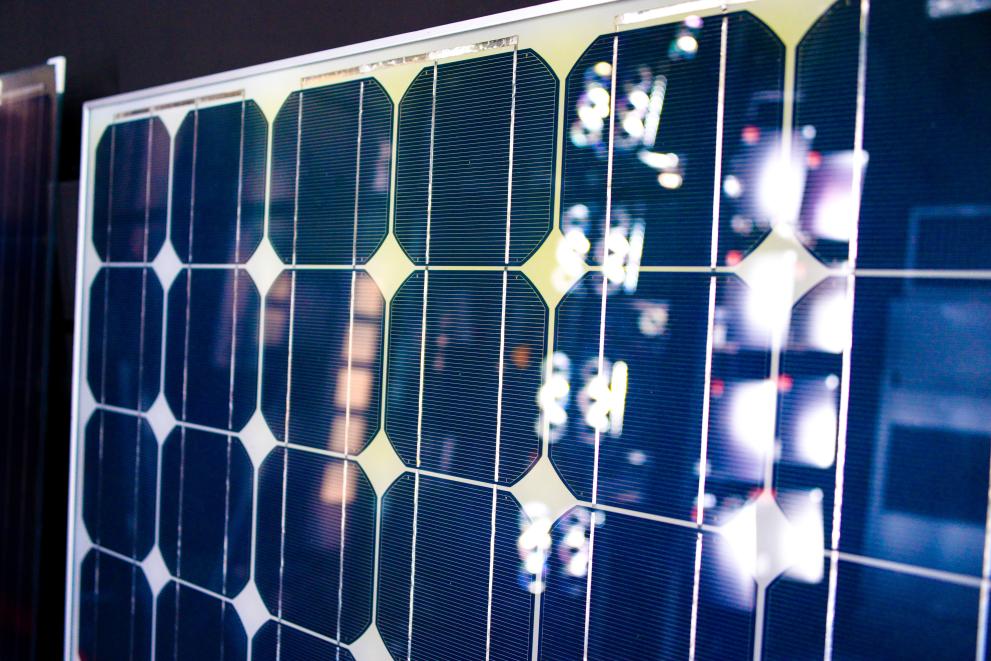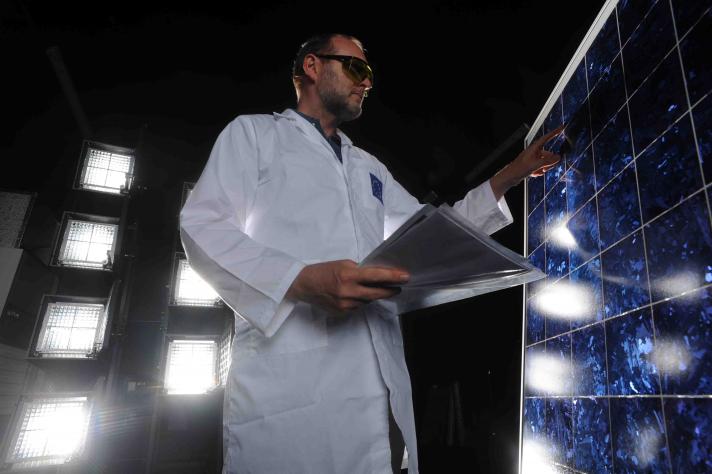The European Solar Test Installation (ESTI) is a European reference laboratory for calibration of photovoltaic (PV) devices and for the verification of their energy generation. Since its launch in the late 1970’s, it also has been the forefront of the development of international standards for the assessment of electrical performance of PV products and for their reliability. ESTI is located at the JRC Ispra site in Italy.
Know more about ESTI with one of our researchers in the following video.
Facilities
ESTI has a unique range of class AAA solar simulators as well as outdoor facilities for accurate calibration, testing and long-term assessment of PV cells and modules.
ESTI indoor facilities
- Oriel continuous solar simulator dedicated to spectral responsivity measurements (between 300 nm and 1900 nm) of:
- PV devices of all technologies up to an area of 30 cm x 30 cm;
- multi-junction PV devices up to dimension of full-size modules.
- Pasan IIA pulsed solar simulator dedicated to spectral responsivity measurement of single-junction PV devices (2 m x 2 m test area)
- San-EI continuous solar simulator for PV Devices up to 22 cm x 22 cm
- Wacom steady-state solar simulator for PV devices up to 10 cm x 10 cm
- Apollo large-area steady-state solar simulator (2 m x 2 m test area)
- Pasan IIIB pulsed solar simulator (3 m x 3 m test area)
- Spire 4600SLP long-pulse (>100 ms) solar simulator (1.5 m x 2 m test area)
- Electroluminescence
- Light-soaking chambers for pre-conditioning of PV devices
- Climatic chambers
- Visual inspection
- Internal metrology laboratory
ESTI outdoor facilities
- reference primary instruments directly traceable to the World Radiometric Reference
- permanent monitoring of the natural spectral irradiance by dedicated spectroradiometers
- facility for PV devices calibration at standard test conditions, provided with sun-tracker and insulated box
- CPV calibration
- Fixed racks for energy-rating studies and verifications
- Fixed racks for long-term exposure studies and verifications
- Permanent monitoring of environmental parameters in support to the fixed-rack tests
Ensurance of Measurements Traceability to Primary Measurement Standards
To have legal validity, all measurements (including PV) are required to have an unbroken traceability chain to international primary measurement standards as well as a calculation of their uncertainty. For PV devices the most important and difficult aspect is the irradiance determination, for which ESTI is accredited for three methods.
The global sunlight method (1st method) and the direct sunlight method (2nd method) transfer the irradiance calibration from two cavity radiometers, which are calibrated every five years against the World Radiometric Reference at the International Pyrheliometer Comparison held in Davos, Switzerland. The solar simulator method (3rd method) makes reference to the international irradiance scale, as represented by a standard lamp.
Accreditation
ESTI maintains a laboratory management system that is compliant to the ISO/IEC 17025 and is accredited for the calibration of photovoltaic devices (LAT 225) by the Italian accreditation body ACCREDIA. The accreditation scheme includes a flexible scope that allows ESTI to develop and implement internally new measurement procedures and methods. The validation procedures applied by ESTI before introducing any variation in the methods under “flexible scope” are described in our instruction Validation of Methods (pdf). We maintain a list of methods that indicates which tests and methods have been modified by ESTI under our “Flexible Scope of Accreditation (pdf)”; the list can be consulted for reference.
ESTI services for the PV community
- Calibration service of reference devices for national laboratories and other external customers and verification on request of technologies developed in EU programmes
- Collaborative research with industrial partners on new materials and/or concepts to promote European competitiveness and improved international standards
- Funded R&D in shared-cost European programmes
For the calibrations price list or for requesting information on our services, please contact: JRC-ESTI-SERVICES ec [dot] europa [dot] eu (JRC-ESTI-SERVICES[at]ec[dot]europa[dot]eu)
ec [dot] europa [dot] eu (JRC-ESTI-SERVICES[at]ec[dot]europa[dot]eu)
ESTI Meteo Tower Data online
Comprehensive metrological solar resource data are essential for evaluating the results of the European Solar Test Installation (ESTI)'s outdoor exposure testing on PV modules. A permanent monitoring of the significant environmental parameters (see details) is carried out thanks to the ESTI meteo tower, whose data are publicly available on the ESTI meteo tower website.
The ESTI meteo tower, located in Ispra (Italy), measures and records minute data of the following parameters:
- Global irradiance on 0° (i.e. horizontal), 45°, 60° and 90° planes [W/m2]
- Diffuse horizontal irradiance [W/m2]
- Direct normal irradiance [W/m2]
- Relative humidity [%]
- Wind speed [km/h]
- Wind direction [° from North clockwise]
- Rain gauge [mm]
- Ambient temperature [°C]
- Local Barometric Pressure [hPa]
Large-Scale Façade
In 1994, an amorphous silicon array was installed under ESTI supervision on the façade of the ELSA building housing the European Laboratory for Structural Assessment. At the time, it was the largest façade installation in the world using amorphous silicon technology.
The main characteristics are:
Total area: 770 m2
Active PV area: 544 m2
Nominal peak power after initial degradation: 21 kWp
Grid connection via four 5kW SMA inverters
Operation with very little downtime since October 1994
International Spectroradiometer Intercomparison (ISRC)
Every year, ESTI organises the International Spectroradiometer Intercomparison (ISRC), a week-long event dedicated to metrology in solar radiation measurements. During the event, participating instruments measure solar radiation continuously, with the ESTI equipment serving as the standard for evaluating spectroradiometers and calibrating pyranometers and pyrheliometers. Additionally, a specialised section of the event focuses on comparing absolute cavity radiometers (ACR), where the assigned value is determined by averaging the valid WRR factors of the cavities from the latest IPC in Davos (PMOD-WRC). A dedicated
collects the results for different sections: spectroradiometers, absolute cavity radiometers, pyranometers and pyrheliometers.
Related Content
Some of the latest ESTI publications
- Using the equivalent cell temperature for power matrix calculations (2024)
- Solar cell efficiency tables (Version 64) (2024)
- Performance evaluation of procedures used to correct measured I-V characteristics of photovoltaic modules for temperature and irradiance (2023)
- Interlaboratory comparison of voltage sweep methods used for the electrical characterization of encapsulated high-efficiency c-Si solar cells (2023)
- Improving spectral responsivity measurements by correcting for filter bandwidth (2023)
- Building criteria for energy labeling of photovoltaic modules and small systems (2022)
- Metastability in performance measurements of perovskite PV devices: a systematic approach (2021)
- Results of the IX International Spectroradiometer Intercomparison and impact on new PV technologies (2021)
- A European proficiency test on thin-film tandem photovoltaic devices (2020)
- Power performance and thermal operation of organic photovoltaic modules in real operating conditions (2020)
- Power matrix of OPV mini-module under steady conditions of temperature and irradiance at large-area solar simulator (2020)
- Consensus statement for stability assessment and reporting for perovskite photovoltaics based on ISOS procedures (2020)
- Intercomparison of high‐efficiency c‐Si modules (2019)
- Linearity of photovoltaic devices: quantitative assessment with N-lamp method (2019)
- Interlaboratory comparison of linearity measurements of photovoltaic devices (2019)
- European round-robins on TC measurements of photovoltaic devices of different size (2019)
- Electrical performance of bifacial silicon PV modules (2019)
- Temperature Coefficients (TC) of bifacial crystalline silicon PV modules (2018)
- Uncertainty budget assessment of temperature coefficient measurements (2018)
- Traceable calibration of photovoltaic reference cells using natural sunlight (2017)
- Uncertainty propagation of Spectral Matching Ratios measured using a calibrated spectroradiometer (2017)
- Calibration procedure for solar cells exhibiting slow response and application to a dye-sensitized photovoltaic device (2017)
- Improvements in world-wide intercomparison of PV module calibration (2017)
Relevant related JRC reports
- State-of-the-art assessment of solar energy technologies (2022)
- State-of-the-art for assessment of solar energy technologies (2020 & 2021)
- State-of-the-art for assessment of solar energy technologies (2019)
- PV energy systems: Summary of the JRC's contribution to International and European standards in 2019
- State-of-the-art for assessment of solar energy technologies (2018)
- PV energy systems: Summary of the JRC's contribution to International and European standards in 2018
Related Documents
Media


European Solar Test Installation (ESTI) in the Joint Research Centre, Ispra, ItalyThe Wacom steady-state solar simulator is for small photovoltaic devices up to 10 cm x 10 cm. The JRC scientist is replacing the small photovoltaic cell after carrying out tests using the solar simulator. 

European Solar Test Installation (ESTI) in the Joint Research Centre, Ispra, ItalyThe SPIRE is a long pulsed solar simulator which is able to test photovoltaic (PV) modules sized 1.5 m x 2 m. When it is coupled with LED bias light, it is especially useful for bifacial module characterisation and allows simultaneously testing of both sides of the solar module. ESTI is at the forefront of the development of international standards for the assessment of electrical performance of PV products. Bifacial photovoltaic modules have shown the potential to increase the performance of traditional photovoltaic module architectures using modified conventional silicon manufacturing techniques. Bifacial modules can produce additional energy from the rear surface of the module, collecting not only light incident on the front surface but also sunlight scattered or reflected from the ground or environment onto the rear surface. 

European Solar Test Installation (ESTI) in the Joint Research Centre, Ispra, ItalyThe SPIRE is a long pulsed solar simulator which is able to test photovoltaic (PV) modules sized 1.5 m x 2 m. When it is coupled with LED bias light, it is especially useful for bifacial module characterisation and allows simultaneously testing of both sides of the solar module. ESTI is at the forefront of the development of international standards for the assessment of electrical performance of PV products. Bifacial photovoltaic modules have shown the potential to increase the performance of traditional photovoltaic module architectures using modified conventional silicon manufacturing techniques. Bifacial modules can produce additional energy from the rear surface of the module, collecting not only light incident on the front surface but also sunlight scattered or reflected from the ground or environment onto the rear surface. 

European Solar Test Installation (ESTI) in the Joint Research Centre, Ispra, ItalyESTI has a unique range of class AAA solar simulators for accurate calibration, testing and long-term assessment of photovoltaic cells and modules. The JRC scientist is carrying out tests on this large photovoltaic module using the Apollo simulator, a large-area steady-state solar simulator which has a 2 m x 2 m test area. 

European Solar Test Installation (ESTI) in the Joint Research Centre, Ispra, ItalyESTI has a unique range of class AAA solar simulators for accurate calibration, testing and long-term assessment of photovoltaic cells and modules. The JRC scientist is carrying out tests on this large photovoltaic module using the Apollo simulator, a large-area steady-state solar simulator which has a 2 m x 2 m test area. 

European Solar Test Installation (ESTI) in the Joint Research Centre, Ispra, ItalyFor photovoltaic devices, the most important and difficult aspect is the irradiance determination which means the power received from the sun. ESTI is accredited for three methods to measure this, using the highest standard cavity radiometers: the global sunlight method (1st method), the direct sunlight method (2nd method), and the solar simulator method (3rd method) which makes reference to the international irradiance scale, as represented by a standard lamp.


